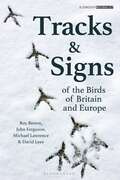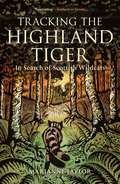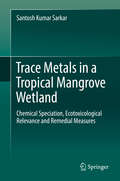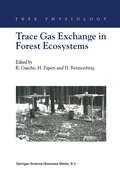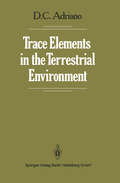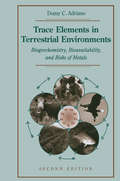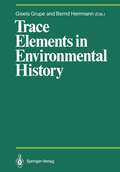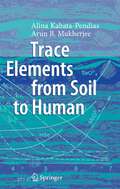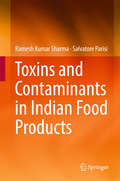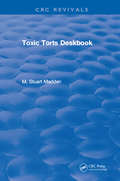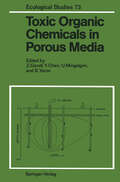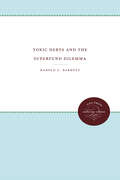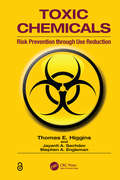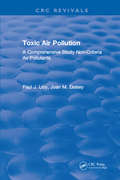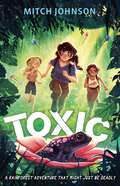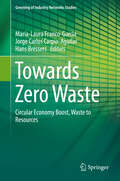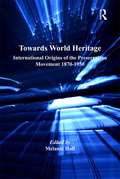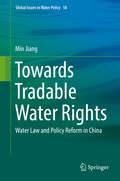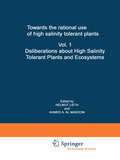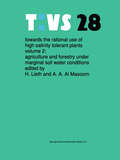- Table View
- List View
Tracks and Signs of the Birds of Britain and Europe (Bloomsbury Naturalist)
by David Lees John Ferguson Michael Lawrence Roy BrownTracks & Signs of the Birds of Britain and Europe contains a wealth of fascinating material for any field naturalist. This unique guide enables the reader to find, interpret and understand field marks left by a variety of birds throughout Britain and Europe, and to use these to identify the species in question. It covers subjects including tracks and trails, feeding and other behavioural signs, nests, pellets, droppings, feathers and skulls, habitat types and field analysis methods. All European bird families are featured, with numerous individual species being described in detail.Fully revised and updated, this third edition contains a great deal of new material, including 19 new colour plates and hundreds of new photographs, line drawings and diagrams. Tracks & Signs of the Birds of Britain and Europe is an indispensable addition to any feather-finder or track-watcher's backpack – the ultimate resource for anyone wanting to identify a bird species from the sometimes subtle clues they leave behind.
Tracking The Highland Tiger: In Search of Scottish Wildcats
by Marianne TaylorOver the centuries, one by one, Britain's most formidable wild animals have fallen to the thoughtless march of humankind. A war on predators put paid to our lynxes, wolves and bears, each hunted relentlessly until the last of them was killed. Only our wildcats lived on.The Scottish wildcat's guile and ferocity are the stuff of legend. No docile pet cat, this, but a cunning and shadowy animal, elusive to the point of invisibility, but utterly fearless when forced to fight for its life. Those who saw one would always remember its beauty – the cloak of dense fur marked with bold tiger stripes, the green-eyed stare and haughty sneer, and the broad, banded tail whisking away into the forest's gloom.Driven to the remnants of Scotland's wilderness, the last few wildcats now face the most insidious danger of all as their domesticated cousins threaten to dilute their genes into oblivion. However, the wildest of cats has friends and goodwill behind it. This book tells the story of how the wildcat of the wildwood became the endangered Scottish wildcat, of how it once lived and lives now, and of how we - its greatest enemy - are now striving to save it in its darkest hour.
Tracking The Highland Tiger: In Search of Scottish Wildcats
by Marianne TaylorOver the centuries, one by one, Britain's most formidable wild animals have fallen to the thoughtless march of humankind. A war on predators put paid to our lynxes, wolves and bears, each hunted relentlessly until the last of them was killed. Only our wildcats lived on.The Scottish wildcat's guile and ferocity are the stuff of legend. No docile pet cat, this, but a cunning and shadowy animal, elusive to the point of invisibility, but utterly fearless when forced to fight for its life. Those who saw one would always remember its beauty – the cloak of dense fur marked with bold tiger stripes, the green-eyed stare and haughty sneer, and the broad, banded tail whisking away into the forest's gloom.Driven to the remnants of Scotland's wilderness, the last few wildcats now face the most insidious danger of all as their domesticated cousins threaten to dilute their genes into oblivion. However, the wildest of cats has friends and goodwill behind it. This book tells the story of how the wildcat of the wildwood became the endangered Scottish wildcat, of how it once lived and lives now, and of how we - its greatest enemy - are now striving to save it in its darkest hour.
Trace Metals in a Tropical Mangrove Wetland: Chemical Speciation, Ecotoxicological Relevance and Remedial Measures
by Santosh Kumar SarkarThis book offers a comprehensive and accessible guide covering various aspects of trace metal contamination in abiotic and biotic matrices of an iconic Indian tropical mangrove wetland – Sundarban. Divided into nine chapters, the book begins by discussing the fundamental concepts of sources, accumulation rate and significance of trace metal speciation, along with the impact of multiple stressors on trace metal accumulation, taking into account both tourist activities and the exacerbating role of climate change. The second chapter presents a detailed account of the sampling strategy and preservation of research samples, followed by exhaustive information on sediment quality assessment and ecological risk, instrumental techniques in environmental chemical analyses, quality assurance and quality control, along with the Sediment Quality Guidelines (SQGs). Using raw data, the sediment quality assessment indices (e.g., pollution load index, index of geoaccumulation, Nemerow Pollution Load Index etc.) and conventional statistical analyses are worked out and interpreted precisely, allowing students to readily evaluate and interpret them. This is followed by chapters devoted to trace metal accumulation in sediments and benthic organisms, as well as acid-leachable and geochemical fractionation of trace metals in sediments. The book then focuses on chemical speciation of butylin and arsenic in sediments as well as macrozoobenthos (polychaetous annelids). Finally, potential positive role of the dominant mangrove Avicennia in sequestering trace metals from rhizosediments of Sundarban Wetland is elaborately discussed. This timely reference book provides a versatile and in-depth account for understanding the emerging problems of trace metal contamination – issues that are relevant for many countries around the globe.
Trace Gas Exchange in Forest Ecosystems (Tree Physiology #3)
by R. Gasche H. Papen H. RennenbergThis volume summarizes the current knowledge on the exchange of trace gases between forests and the atmosphere with the restriction that exclusively carbon and nitrogen compounds are included. For this purpose the volume brings together and interconnects knowledge from different disciplines of biological and atmospheric sciences. It covers microbial and plant processes involved in the production and consumption of these trace gases; the exchange processes between forest soils and vegetation on the one hand, and the atmosphere on the other hand; the fate of the trace gases exchanged inside the atmosphere as well as environmental influences on the exchange of trace gases between forest ecosystems and the atmosphere. With this interdisciplinary approach the volume provides the background for an evaluation of the exchange of trace gases between forest ecosystems and the atmosphere and man-made disturbances of this exchange.
Trace Elements in the Terrestrial Environment
by Domy C. AdrianoI intend to fill, with this book, a need that has long been felt by students and professionals in many areas of agricultural, biological, natural, and environmental sciences-the need for a comprehensive reference book on many important aspects of trace elements in the "land" environment. This book is different from other books on trace elements (also commonly referred to as heavy metals) in that each chapter focuses on a particular element, which in tum is discussed in terms of its importance in our economy, its natural occurrence, its fate and behavior in the soil-plant system, its requirement by and detriment to plants, its health limits in drinking water and food, and its origin in the environment. Because of long distance transport to pristine areas of cadmium, lead, copper, and zinc in relatively large quantities, these elements have an extra section on natural ecosystems. A blend of pictorial and tabular data are provided to enhance understanding of the relevant information being conveyed. Since individual chapters are independent of one another, they are arranged alphabetically. However, readers with weak backgrounds in soil science are advised to start with the chapter on zinc, since soil terminology is discussed in more detail here. Sections on sorption, forms and speciation, complexation, and transformations become more technical as soil physical-(bio )chemical phenomena are discussed. The less important "environmental" trace elements are discussed together in the "Other Trace Elements" chapter.
Trace Elements in Terrestrial Environments: Biogeochemistry, Bioavailability, and Risks of Metals
by Domy C. AdrianoA comprehensive reference handbook on the important aspects of trace elements in the land environment. Each chapter addresses a particular element and gives a general introduction to their role in the environment, where they come from, and their biogeochemical cycles. In addition to a complete updating of each of the element chapters, this new edition has new chapters devoted to aluminum and iron, soil contamination, remediation and trace elements in aquatic ecosystems. In short, an essential resource for environmental scientists and chemists, regulators and policy makers.
Trace Elements in Environmental History: Proceedings of the Symposium held from June 24th to 26th, 1987, at Göttingen (Proceedings in Life Sciences)
by Gisela Grupe Bernd HerrmannThis book contains the contributions to an European symposium on "Trace Elements in Environmental History", held from June 24th to 26th at GCittingen, FRG. The confe rence was organised by the Institute of Anthropology of the Georg August-University in GCittingen. At first glance, it might be surprising that the organizers are anthropolo gists. But this is a result of change of paradigm prehistoric anthropology is facing at the time. For decades, population development and population processes in the past have been looked at in terms of morphology, thus describing the diversity of human populations by the outer appearance of the skeletal findings and by the reconstruction of population structures. The new approach concentrates less on how people in the past looked like, but moreover on what they did and how they lived. Thus, research is based on ecosystem-theories, and it aims on the evaluation of ancient ecological features and past man/environment relationships. Research is encouraged since anthropologists are asked a lot of questions by historians and social scientists, who became more and more interested in the history of every day's life. Prehistoric anthropology today focu ses also on manners, habits, ways of life and environmental constituents as they can be traced from skeletal remains, which represent an important historical source. The ecosystemic approach is promising since the experiences of daily life certainly influence human behaviour, life style and mentality, thus directing reproduction and therefore population development.
Trace Elements from Soil to Human
by Alina Kabata-Pendias Arun B. MukherjeeThe quality of food is such a live issue at the moment that this title is an essential tool for researchers in a variety of disciplines. It provides a review of the key features of trace elements in soils, plants and the food web on which human beings survive. The authors' intention is to summarize up-to-date interdisciplinary data for the concise presentation of our understanding of trace-element transfer in the chain from soil to man.
Toxins and Contaminants in Indian Food Products
by Ramesh Kumar Sharma Salvatore ParisiThis book discusses different aspects of contamination in Indian food products. Particular attention is given to the presence and analytical detection of detrimental substances such as pesticides, mycotoxins and other biologically-produced toxins, food chemicals and additives with natural or industrial origin. Furthermore, the book addresses the production and the commercial exploitation of native botanical ingredients, and the question if such ingredients should be regarded as foods or drugs. It also sheds light on chemical aspects of organic farming practices in India. Readers will also find information on pesticides and other detrimental chemicals detection in Indian farming. The authors present a useful opinion on how and why food contaminants can lead to border rejections during export, in particular to the European Union.
Toxic Torts Deskbook
by M. Stuart MaddenToxic Torts Deskbook is a concise, readable text covering the fastest-growing area of tort and personal injury litigation.Toxic tort suits involve claims arising from exposure to products ranging from pesticides to industrial solvents, manufacturing waste, and asbestos and present unique questions regarding causation, degree of hazard, and expert testimony.Written for environmental professionals as well as attorneys, Toxic Torts Deskbook describes the principal causes of suits for negligence, nuisance, trespass, warranty, strict tort liability, and liability for abnormally dangerous activities. For environmental, product, and workplace injuries from toxic exposure, the book discusses the elements a claimant must plead and prove, as well as defenses, statutes of limitations for long latency harms, and limited immunity for government contractors. "Citizen suits" that individuals may bring to vindicate rights granted by state or federal environmental statutes and insurance coverage issues, including the metes and bounds of the "pollution exclusion", are also covered.
Toxic Torts Deskbook
by M. Stuart MaddenToxic Torts Deskbook is a concise, readable text covering the fastest-growing area of tort and personal injury litigation.Toxic tort suits involve claims arising from exposure to products ranging from pesticides to industrial solvents, manufacturing waste, and asbestos and present unique questions regarding causation, degree of hazard, and expert testimony.Written for environmental professionals as well as attorneys, Toxic Torts Deskbook describes the principal causes of suits for negligence, nuisance, trespass, warranty, strict tort liability, and liability for abnormally dangerous activities. For environmental, product, and workplace injuries from toxic exposure, the book discusses the elements a claimant must plead and prove, as well as defenses, statutes of limitations for long latency harms, and limited immunity for government contractors. "Citizen suits" that individuals may bring to vindicate rights granted by state or federal environmental statutes and insurance coverage issues, including the metes and bounds of the "pollution exclusion", are also covered.
Toxic Organic Chemicals in Porous Media (Ecological Studies #73)
by Zev Gerstl Y. Chen U. Mingelgrin Bruno YaronIn March, 1983 a workshop on Pollutants in Porous Media was hosted by the Institute of Soils and Water of the Agricultural Research Organi zation in Bet Dagan, Israel. At this workshop, the unsaturated zone be tween the soil surface and groundwater was the focal point of discus sions for scientists from various disciplines such as soil chemists, physicists, biologists and environmental engineers. Since then, the prob lem of soil and water pollution has only worsened as more and more cases of pollution caused by human activities including agriculture and industry have been revealed. A great deal of work has been carried out by environmental scientists since 1983 in elucidating the behavior of the many classes of pollutants and the complex physical, chemical, and bio logical transformations which they undergo as they move through the soil to the vadose zone and, in many cases, the groundwater. In light of this, it was felt that another meeting of specialists from the many disciplines which deal with this subject was necessary and so a Second International Workshop on the Behavior of Pollutants in Porous Media, sponsored by IUPAC (the International Union of Pure and Applied Chemistry) and IAHS (the International Association of Hydrological Sciences), was organized and held in the Institute of Soils and Water of the Agricultural Research Organization in Bet Dagan, Israel during 1987. June, The present volume is a selection of the talks presented at this second workshop and deals only with toxic organic chemicals in porous media.
Toxic Debts and the Superfund Dilemma
by Harold C. BarnettIn 1980, with the passage of the Comprehensive Environmental Response, Compensation, and Liability Act, Congress created the Superfund as a mechanism to clean up the toxic legacy of the industrial and chemical revolutions. Over a decade later, the consensus is that the program has failed: too much has been spent and too little accomplished. Harold Barnett unravels the history of this failure, examining the economic and political factors that contributed to it and suggesting policy changes necessary to create a viable cleanup program. Barnett argues that the Superfund has failed because of conflict over who will pay the toxic debt and the impact of this conflict on interdependent funding and enforcement decisions at state, regional, and national levels. He argues that the inability of legislators and regulatory agencies to take effective and timely action is related to the economic and political power of major corporate polluters. Spanning the Reagan and Bush administrations, the book highlights the ongoing conflict between deregulatory policies and environmental programs.Originally published in 1994.A UNC Press Enduring Edition -- UNC Press Enduring Editions use the latest in digital technology to make available again books from our distinguished backlist that were previously out of print. These editions are published unaltered from the original, and are presented in affordable paperback formats, bringing readers both historical and cultural value.
Toxic Chemicals: Risk Prevention Through Use Reduction
by Thomas E. Higgins Jayanti A. Sachdev Stephen A. EnglemanCatastrophic events such as the Bhopal, India tragedy and rising incidences of cancer in areas neighboring industrial facilities have heightened concern over the use of toxic chemicals in manufacturing and industry. Based on the authors' research conducted in Sao Paulo, Brazil, this book explores the history of toxic chemical release reporting programs, presents data on the toxicity of chemicals currently in use, discusses variables that contribute to the relative toxicity of a substance, compares existing programs for reducing environmental threats, and provides specific recommendations for reducing or eliminating the use of toxic chemicals.
Toxic Chemicals: Risk Prevention Through Use Reduction
by Thomas E. Higgins Jayanti A. Sachdev Stephen A. EnglemanCatastrophic events such as the Bhopal, India tragedy and rising incidences of cancer in areas neighboring industrial facilities have heightened concern over the use of toxic chemicals in manufacturing and industry. Based on the authors' research conducted in Sao Paulo, Brazil, this book explores the history of toxic chemical release reporting programs, presents data on the toxicity of chemicals currently in use, discusses variables that contribute to the relative toxicity of a substance, compares existing programs for reducing environmental threats, and provides specific recommendations for reducing or eliminating the use of toxic chemicals.
Toxic Air Pollution: A Comprehensive Study Non-Criteria Air Pollutants
by Paul J. LioyThe difficulties with addressing toxic air pollutants are the cheer number of compounds present in the atmosphere and their sources. The purpose of this book is to develop an approach to understanding toxic air pollutants through synthesis of the scientific results obtained in the Airbourne Toxic Element and Organic Substance (ATEOS) project.
Toxic Air Pollution: A Comprehensive Study Non-Criteria Air Pollutants
by Paul J. LioyThe difficulties with addressing toxic air pollutants are the cheer number of compounds present in the atmosphere and their sources. The purpose of this book is to develop an approach to understanding toxic air pollutants through synthesis of the scientific results obtained in the Airbourne Toxic Element and Organic Substance (ATEOS) project.
Toxic: A rainforest adventure that might just be deadly.
by Mitch JohnsonHidden in the heart of the rainforest lies a secret... can three friends can survive long enough to find it? An action-packed jungle adventure, perfect for fans of Katherine Rundell's The Explorer and M.G. Leonard's Twitch.Billionaire beauty mogul Anura Hegarty has pledged to acquire as much of the rainforest as possible to preserve it. But when armed guards appear and bring in portable terrariums to capture wildlife, Jessica and her friend Renata realise something much more sinister is going on.The rainforest holds a frog with a secret to staying young forever, and Jessica and Renata know they must find and save it first! Together with Briony-Rose, the girls journey deeper into the rainforest. Danger and betrayal lurk in every corner, and soon they're running for their lives, dodging blow darts and falling into traps. Will the children make it out of the forest alive?Praise for Mitch Johnson'Fizzes with adventure and great characters who pop from the page' - Peter Bunzl, bestselling author of Cogheart'I read it all in one gulp!' - Ross Welford, bestselling author of Time Travelling with a Hamster'A bonkers Willy-Wonka nightmare designed to get children thinking about the effects of everything they buy' - Ross Montgomery, bestselling author of The Midnight Guardians'A zany adventure that will make you bubble with laughter and fizz with indignation on behalf of our planet' - Maria Kuzniar, bestselling author of The Ship of Shadows'An exploding soda geyser of a book - an adventure story that will make you laugh, make you angry and make you want to do something to fix this crazy, messed up world' - Charlie Higson, bestselling author of Young Bond and The Enemy'Pop! is an explosive and unforgettable adventure with defiant heroes, devious villains, deadly corporate secrets all told with Johnson's brilliant humour. I loved it' - Tamsin Winter, bestselling author of Jemima Small Versus the Universe
Towards Zero Waste: Circular Economy Boost, Waste to Resources (Greening of Industry Networks Studies #6)
by María-Laura Franco-García Jorge Carlos Carpio-Aguilar Hans BressersThis book draws on insights that originated from the Circular Economy and Zero Waste initiatives. Together these approaches try to boost the shift from “waste” to “resources” management. The content of this book is partially organized from a stakeholder perspective, revealing the managerial implications for public and private actors. Next to public policies, also illustrations come from the private sector. Petstar, Texperium and Walmart generously shared some of their best practices at in this regard. Cases from China, Indonesia, Mexico, the Netherlands and Romania are discussed in this book. In all of these different contexts they show ways to create collaborative schemes in order to “retain” the resources’ values as much as product quality and financial circumstances permit. The reader can thus take advantage of the pragmatic viewpoints that aim to inspire policy makers, researchers, students, organisations and communities to boost the needed changes towards a Zero Waste Economy.
Towards World Heritage: International Origins of the Preservation Movement 1870-1930
by Melanie HallHistoric preservation, whether of landscapes or buildings, was an important development of the nineteenth century in many countries. There is however surprisingly little understanding about how it took place, and research into it is narrowly focused. For example, generally landscape preservation from this time is examined separately from buildings; preservation is seen in terms of national narratives, or considered within the contexts of area studies, and it is usually seen from a specific disciplinary perspective. All of these later categorizations did not apply at the time and consequently, a very partial view is achieved. In order to begin unlocking a very complex phenomenon that has helped to define our own age, this dynamic collection of essays brings together an international and transdisciplinary line-up of academics and practitioners to reconsider preservation's origins in the second half of the nineteenth and early part of the twentieth century. With a focus on Britain and the British Empire, and including case studies from the United States, Canada, Sweden, France, Germany, Sri Lanka, 'The Holy Land', and Turkey, this book places preservation in imperial, international, and national contexts, demonstrating that there was far more interaction between different countries in this arena than may be supposed and revealing remarkable but hitherto hidden overlaps and intersections. It examines three main themes: the influence of religion; the political and sub-diplomatic aspects of preservation; and the professionalization of preservation practice. Internationalizing trends already existed through the churches, the universities, and the diplomatic services, as well as familial ties that had an important impact on preservation's epistemic communities and its targets. Other internationalizing factors include an interest in national histories and the histories of architecture and art, particularly when known through illustration; a growing interest in biography especially of 'founding fathers' or famous literary figures; and tourism. Although the focus is on architectural preservation, this book demonstrates that, in this formative period, the preservation of buildings and landscapes needs to be considered together - as it often was at the time - and in context. The conclusion reached is that the preservation movement has to be understood in imperial and international contexts, rather than in simply national or regional ones.
Towards World Heritage: International Origins of the Preservation Movement 1870-1930
by Melanie HallHistoric preservation, whether of landscapes or buildings, was an important development of the nineteenth century in many countries. There is however surprisingly little understanding about how it took place, and research into it is narrowly focused. For example, generally landscape preservation from this time is examined separately from buildings; preservation is seen in terms of national narratives, or considered within the contexts of area studies, and it is usually seen from a specific disciplinary perspective. All of these later categorizations did not apply at the time and consequently, a very partial view is achieved. In order to begin unlocking a very complex phenomenon that has helped to define our own age, this dynamic collection of essays brings together an international and transdisciplinary line-up of academics and practitioners to reconsider preservation's origins in the second half of the nineteenth and early part of the twentieth century. With a focus on Britain and the British Empire, and including case studies from the United States, Canada, Sweden, France, Germany, Sri Lanka, 'The Holy Land', and Turkey, this book places preservation in imperial, international, and national contexts, demonstrating that there was far more interaction between different countries in this arena than may be supposed and revealing remarkable but hitherto hidden overlaps and intersections. It examines three main themes: the influence of religion; the political and sub-diplomatic aspects of preservation; and the professionalization of preservation practice. Internationalizing trends already existed through the churches, the universities, and the diplomatic services, as well as familial ties that had an important impact on preservation's epistemic communities and its targets. Other internationalizing factors include an interest in national histories and the histories of architecture and art, particularly when known through illustration; a growing interest in biography especially of 'founding fathers' or famous literary figures; and tourism. Although the focus is on architectural preservation, this book demonstrates that, in this formative period, the preservation of buildings and landscapes needs to be considered together - as it often was at the time - and in context. The conclusion reached is that the preservation movement has to be understood in imperial and international contexts, rather than in simply national or regional ones.
Towards Tradable Water Rights: Water Law and Policy Reform in China (Global Issues in Water Policy #18)
by Min JiangThis book provides a first comprehensive legal examination of water rights arrangements and water rights trading in China. Although recent water reform in China has made substantial progress in policy development and practice, how its legal and institutional framework facilitates or hinders the application of tradable water rights remains less addressed in the existing scholarship. Against the backdrop of China’s water reform and the wider international debate in water governance, this book aims to provide an innovative approach to the complex issue of water governance by critically analysing the recent legal and policy developments in China towards tradable water rights. It examines the deficiencies of the current systems for water rights arrangements and trading, explores how China may learn from and build on the international trends in water rights trading practice (mainly Australia and the US), and proposes legal and policy frameworks for defining and administering tradable water rights in China that underpin sustainable water use in the face of exacerbated water scarcity, variability, and uncertainty. All in all, the book proposes pragmatic strategies for China’s water law and policy reform to move towards tradable water rights, which encompasses a comprehensive prescription from initialising and defining tradable water rights to administering water rights and trading. By reflecting on the deepening water reforms in both China and other jurisdictions, the book aims to contribute to the international water governance debate by exploring from a legal and policy perspective, how China, comparative to other cases around the world, can find a balanced combination of water allocation mechanisms to address its water challenges. It is hoped that the observations and proposed implications for China’s water reform will contribute to developing a better understanding of the way in which experiences in water markets can be shared from jurisdiction to jurisdiction.
Towards the rational use of high salinity tolerant plants: Vol 1: Deliberations about High Salinity Tolerant Plants and Ecosystems (Tasks for Vegetation Science #27)
by Helmut Lieth A. A. Al MasoomThe symposium on high salinity tolerant plants, held at the University of Al Ain in December 1990, dealt primarily with plants tolerating salinity levels exceeding that of ocean water and which at the same time are promising for utilization in agriculture or forestry. The papers of the proceedings of this symposium have been published in two volumes. This volume (1) deals with mangroves and inland high salinity tolerant plants and ecosystems and is divided into the following categories: 1. Vegetation analyses and descriptions of mangroves; 2. Ecosystem analyses; 3. Physiological analyses; 4. Utilization of mangroves and saltmarsh plants; 5. Soil and water analyses. Volume 2 deals with the improvement of salinity tolerance for traditional crops under marginal soils and irrigation water and is published in `Tasks for Vegetation Science' series (TAVS) Vol. 28.
Towards the rational use of high salinity tolerant plants: Vol 2: Agriculture and forestry under marginal soil water conditions (Tasks for Vegetation Science #28)
by Helmut Lieth A. A. Al MasoomThe Symposium on high salinity tolerant plants, held at the University of Al Ain in December 1990, dealt primarily with plants tolerating salinity levels exceeding that of ocean water and which at the same time are promising for utilization in agriculture or forestry. These plants could be very useful for a country like the UAE where fresh water resources are very scarce and the groundwater available at some places is already very salty. More than 60 million woody trees/shrubs have been planted so far and more are planned for the inland plains underlain with brackish groundwater. These species were no solution for the widely barren shoreline of the UAE. Here mangrove species were of potential use, and one species, Avicennia Marina, occurs widely and has been successfully planted for about a decade. Converting the tree plantations into economically useful cropping systems is still a problem requiring much research and development. The book deals in several sections with conventional irrigation systems using marginal water. The species used in these systems are mostly hybrids of conventional crops. The irrigation systems, however, have similar problems as may be expected for irrigation with seawater. Papers show the participants' experiments in this area. The volume serves as a link between scientists working for the improvement of classical irrigation systems and those interested in the application of a new dimension of salinity levels for irrigation water.
